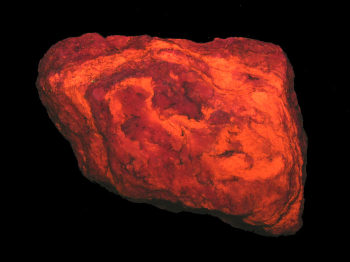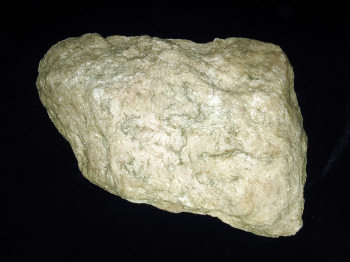Database of luminescent minerals
TREMOLITE
Chemical formula: XCa2Mg5Si8O22(OH)2
Family: Silicates
Status: IMA-A
Crystal system : Monoclinic
Display mineral: NON
Associated names (luminescent varieties, discredited names, synonyms, etc.): hexagonite,
Luminescence:
Longwave UV (365nm) colors: |
Orange , Yellowish White , Pale Yellow , Yellowish , | ||
Shortwave UV (254nm) colors: |
Orange Red , Bluish White , Yellow , Blue , sky-blue , | ||
Daylight picture
Shortwave (254nm) picture

TREMOLITE under uvSW
Photo and Copyright: James Hamblen
Site of the author
Used with permission of the author
Do you have a photo of this mineral you would like to see in the gallery? Contact us!
Phosphorescence (in the common sense of the term) observable with the naked eye:
Type d'UV |
Couleur |
Intensité |
Fréquence d'observation |
|---|---|---|---|
UV courts (254 nm): | Red |
Triboluminescence: OUI
Thermoluminescence: OUI
Comments:
Gouverneur Talc Co, Balmat and Talcville: tremolite (fl. orange SW) associated with tirodite (fl.red SW) and talc (fl. yellow SW).
Activator(s) and spectrum:
Activator(s): Mn2+ , Cr3+, Fe3+,
Peaks in the spectrum (nm):
Mn2+I repl. Ca2+ : 580nm Fe3+ repl. Si4+ : 720-740nm Cr3+ repl. Mg2+? : 690-698nm
No spectrum yet
Best localities for fluorescence (*):
- Gouverneur Talc Co, Balmat and Talcville, St Lawrence County, New York, USA ;
- Edwards , New York, USA; (fluo orange SW and triboluminescent);
- Rhein property, Amity, Town of Warwick, Orange Co., New York, USA (white-blue SW);
- Conklin Limestone Company quarry, Falls Village, Canaan, Litchfield Co., Connecticut, USA (blue SW);
- Farber Quarry, Franklin, New jersey, USA (blue SW);
- Nellie Ulmer Quarry, Rockland, Maine, USA;
- Tremola, Switzerland (bright yellow thermoluminescence);
- Canaan, Litchfield Co., Connecticut, USA (SW yellow);
- Yerington, Yerington District, Singatse Range, Lyon Co., Nevada, USA (Blue-white LW);
- Elsfjord, Vefsn, Nordland, Norway (blue SW);
- Campolungo, Piumogna Valley, Leventina, Ticino (Tessin), Switzerland (blue SW);
- Gilgit-Baltistan, Pakistan;
(*)The data are not exhaustive and are limited to a few remarkable localities for fluorescence
Bibliographic reference for luminescence:
- The Henkel Glossary of Fluorescent Minerals, Dr. Gerhard Henkel, Published by the FMS, 1989 ,
- The World of Fluorescent Minerals, Stuart Schneider, Schiffer Publishing, 2006, ISBN 0-7643-2544-2 ,
- Luminescent Spectra of Minerals, Boris S. Gorobets and Alexandre A. Rogojine, Moscow, 2002 ,
- Handbook of Fluorescent Gems and Minerals, a practical guide for the gem and mineral collector, Jack de Ment, 1949 ,
Reference for luminescence on the Internet:
Images
Mineralogical reference on the Internet:
 http://www.mindat.org/show.php?name=Tremolite
http://www.mindat.org/show.php?name=Tremolite
 http://webmineral.com/data/Tremolite.shtml
http://webmineral.com/data/Tremolite.shtml
Internet Search:
 Image search on 'Google Images'
Image search on 'Google Images'
 Search for documents in all languages on Google
Search for documents in all languages on Google
A request providing no result means only that no such reference exists in the database, but it does not mean that what you are looking for does not exist, just not to our knowledge. If you think you have found an error or omission, please let us know via the contact page being sure to cite the source of information.

